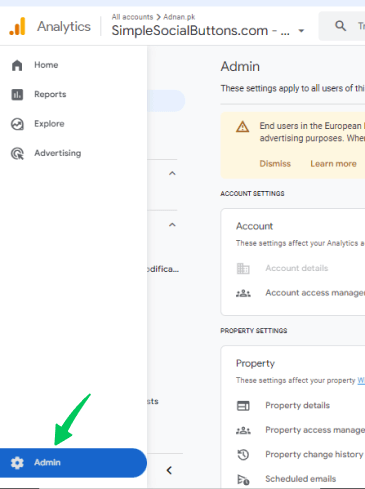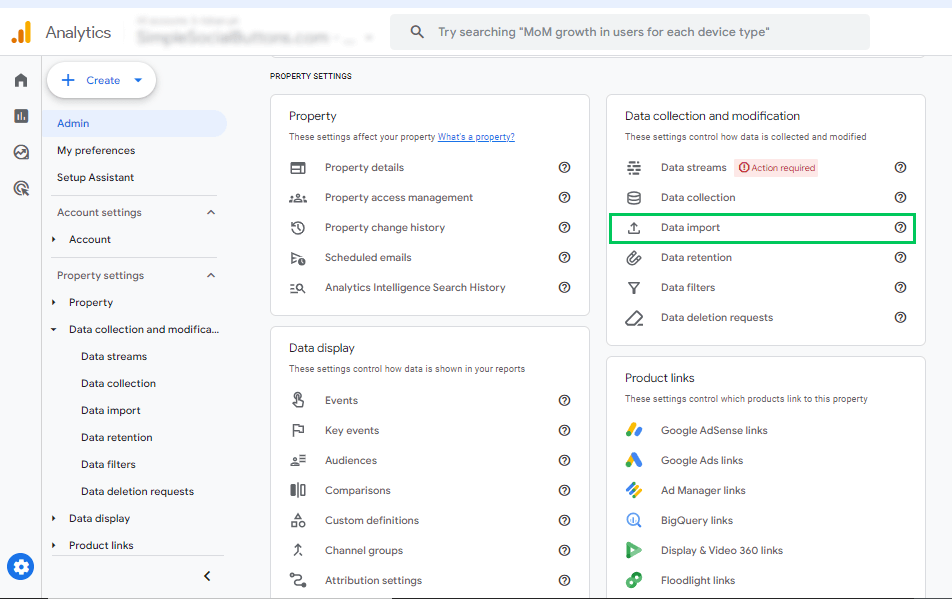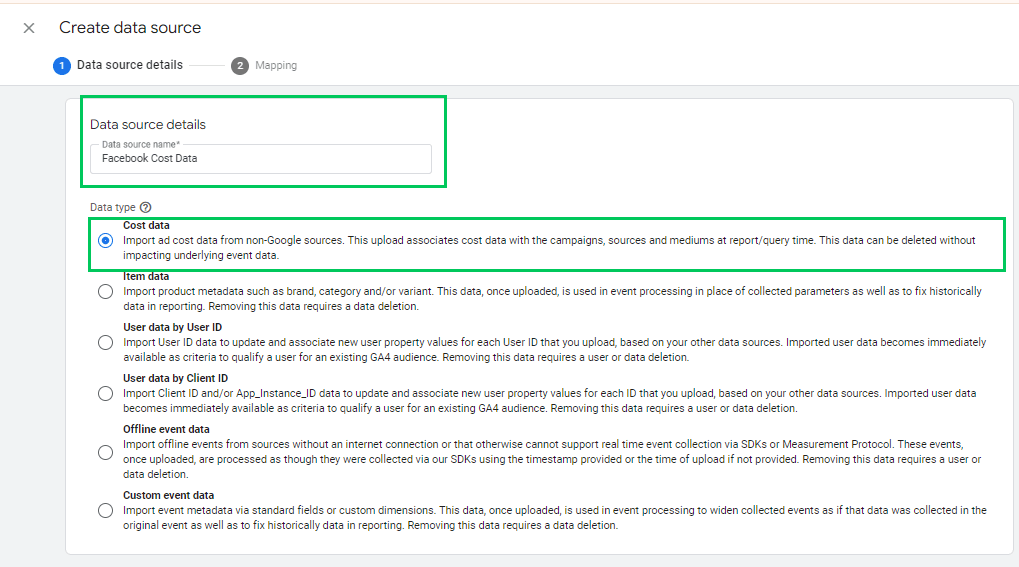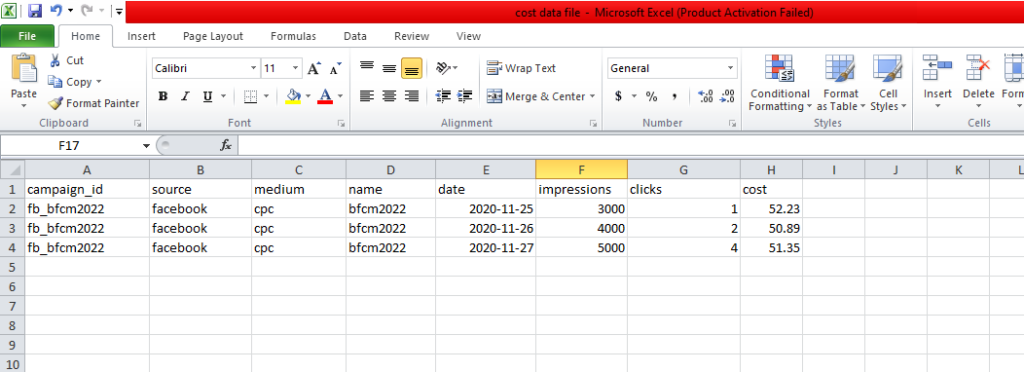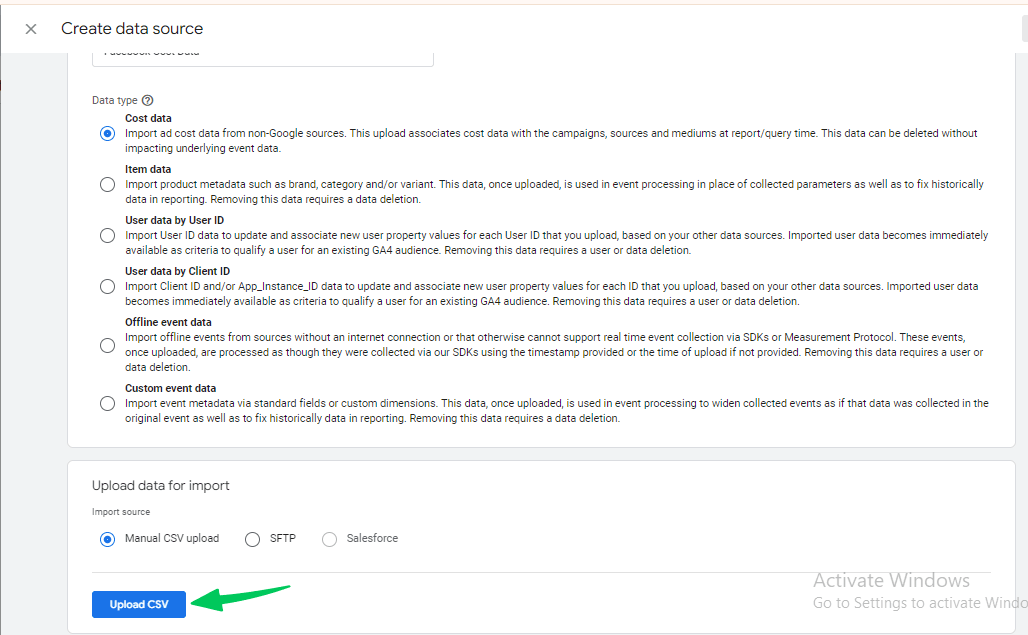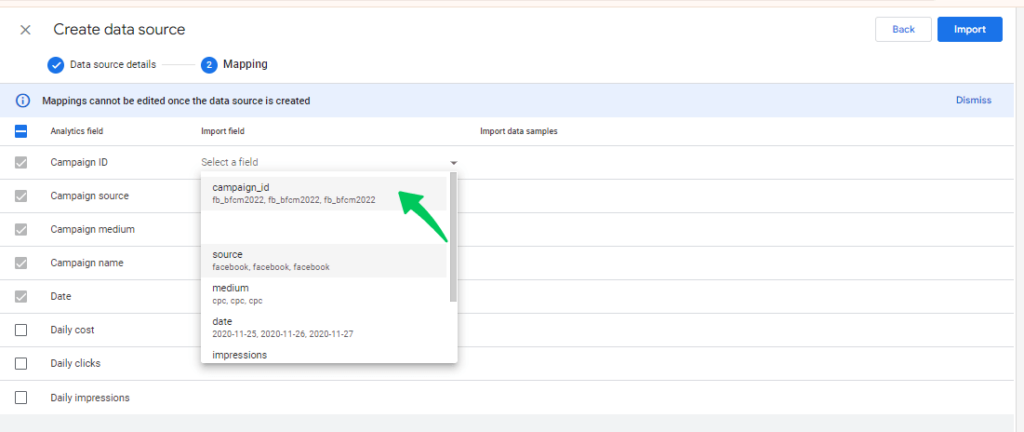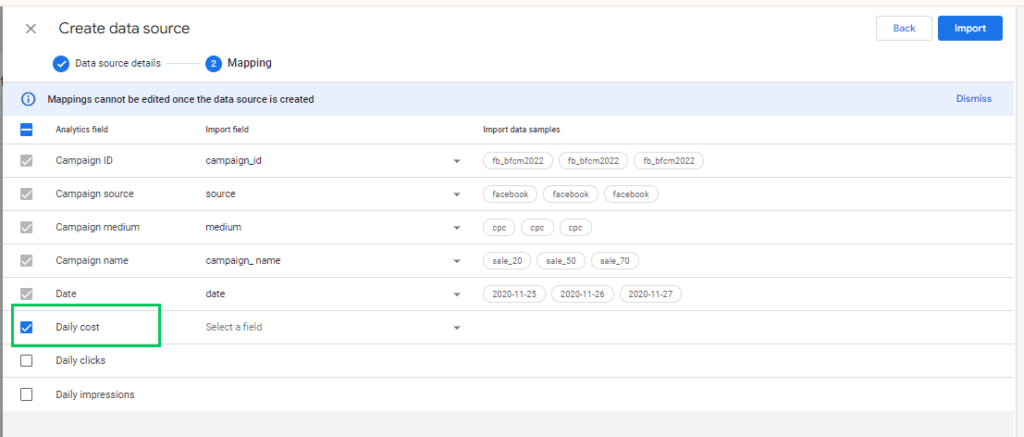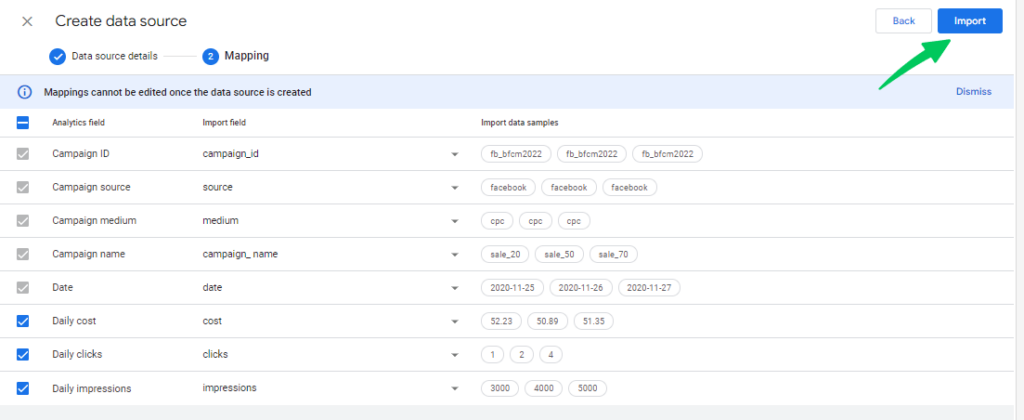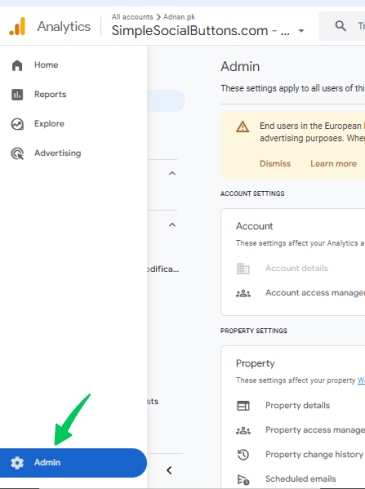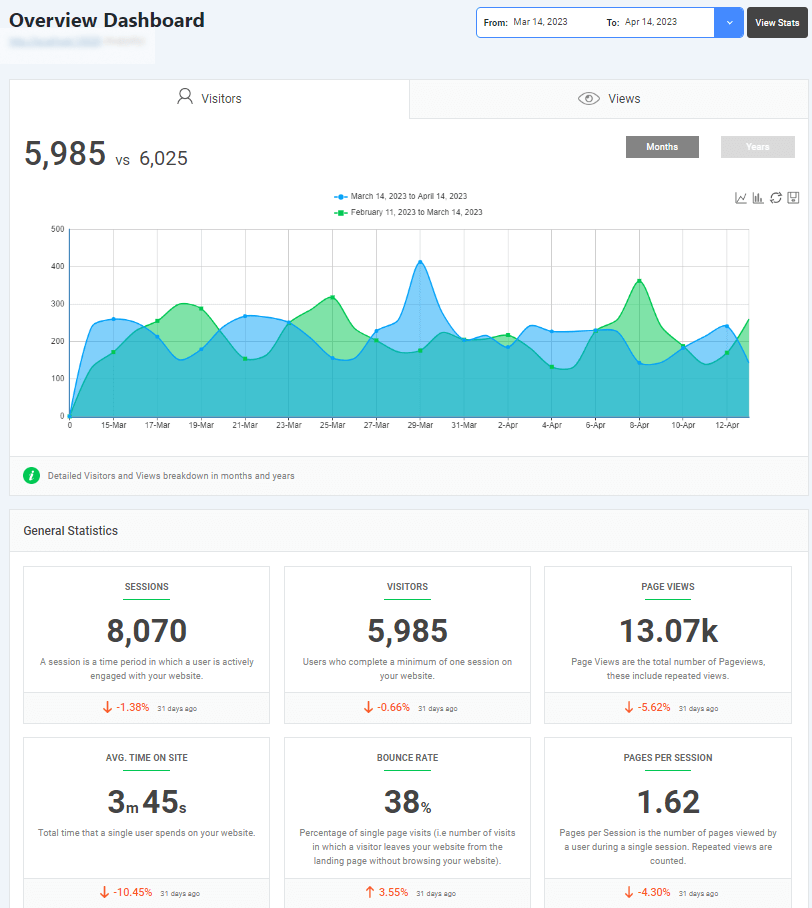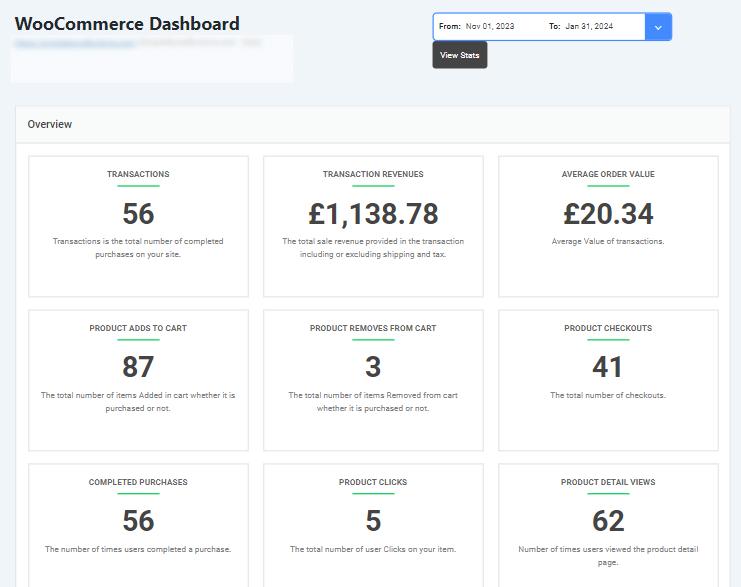
GA4 Data Import (Ultimate Guide 2025)
Have you ever wondered how you can seamlessly merge all your marketing and sales data into one powerful analytics platform? GA4 data import capabilities allow you to integrate various data sources, providing a holistic view of your user interactions and business performance.
Whether you’re looking to combine offline and online data, enhance your reporting accuracy, or gain a deeper understanding of your customer journey, GA4 data import is essential.
In this ultimate guide, we’ll walk you through importing data into GA4, offering step-by-step instructions to help you utilize this powerful feature.
Let us get started!
GA4 Data Import (TOC):
What is Data Import?
Data import transfers data from external sources into a specific software or platform. The data can come from various formats, such as CSV, Excel, or databases.
Data Import in Google Analytics 4 enables you to merge data from your website or app (already tracked by GA4) with information from offline sources like your CRM or sales system.
This integration creates a more complete picture of your customer’s journey, allowing you to analyze online and offline interactions in a single platform.
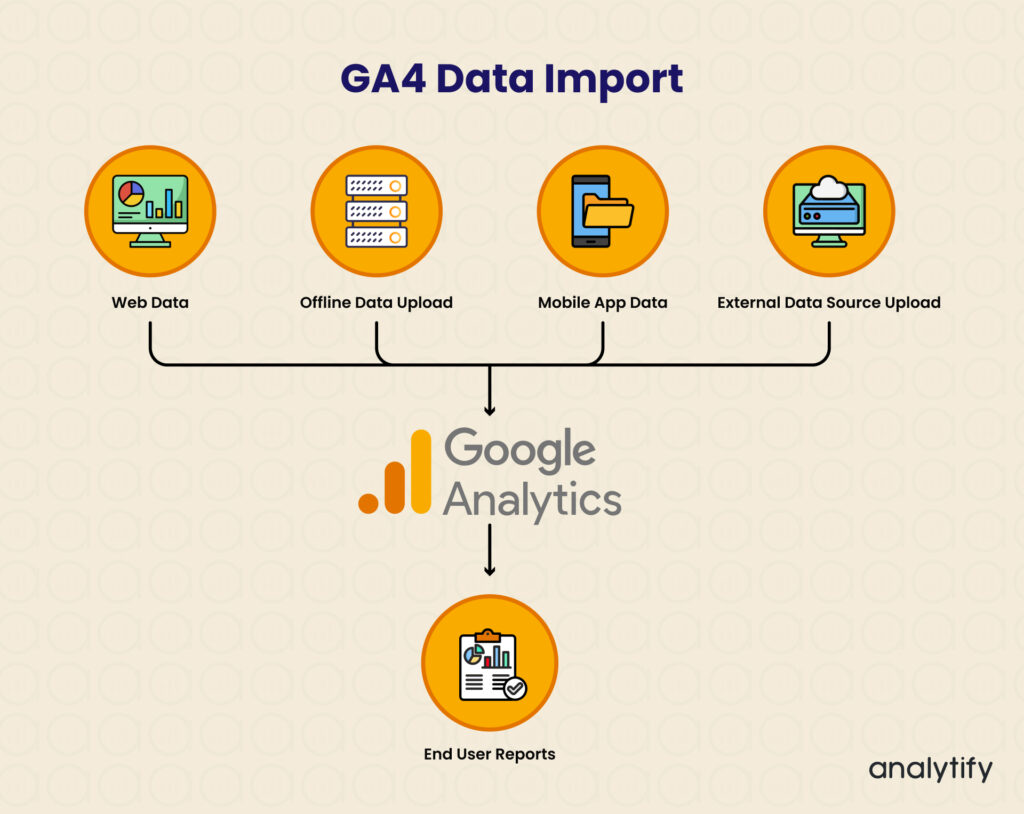
How GA4 Data Import Works?
GA4 data import allows you to enrich your analytics data by incorporating external information from various sources. This process involves uploading data in a specific format, mapping it to corresponding GA4 fields, and then integrating it into your analytics reports.
Data Preparation and Upload
- Data format: Prepare your data in a CSV format, ensuring accuracy and consistency.
- Data mapping: Define how your data aligns with GA4 fields for seamless integration.
- Data upload: Upload your CSV file to GA4 using the designated data import interface.
Data Joining Methods
GA4 supports different data types: cost, item, user, offline event, and custom event data.
- Collection/Processing Time: The imported data becomes part of the main dataset and is treated as if it was collected alongside the regular Analytics events. However, it’s important to note that this joining process doesn’t affect historical Analytics data. If you delete the imported data file, future data won’t be joined, but the previously combined data will remain in your reports. This method is used for user and offline event data.
- Reporting/Query Time: The imported data is combined with your Analytics data only when you access a report. This join type is temporary, and the combined data is not stored permanently. If you delete the imported data file, the joined data will no longer be available in your reports.
- Data processing: GA4 processes the imported data and combines it with existing analytics data to create a unified dataset.
To enhance your analysis capabilities in GA4, it’s essential to learn how to use data import in Google Analytics effectively, especially for integrating offline data like cost information from various advertising platforms.
Why Import Data to Google Analytics 4?
Google Analytics 4 (GA4) offers powerful built-in data collection capabilities, importing external data and enhancing your analytics experience. Here’s why you should consider importing data into GA4:
- Enhanced Reporting and Analysis: Combine online and offline data in your reports and analyses, allowing you to identify trends and patterns that might not be evident with online data alone. Integrate data from various sources, including offline transactions or customer loyalty programs, to completely understand customer behavior.
- Improved Customer Understanding: Analyze various data points, such as purchase history and in-store interactions, to better understand your customers.
- Measure Campaign Effectiveness: Import cost data from various platforms to calculate return on ad spend (ROAS) and optimize your marketing campaigns for better results.
- To create a marketing campaign: Imported customer data can be used to create personalized marketing campaigns and recommendations, leading to higher engagement and conversions.
- Understand customer preference: Analyze imported product data (e.g., size, color) to understand customer preferences and optimize product offerings.
- Create Custom User Segments: Import user data, such as loyalty ratings or lifetime customer value, to create custom audiences for targeted marketing campaigns.
By importing relevant data into GA4, you can improve your understanding of your customers and business to achieve strategic goals.
Types of Data Available for Import in GA4
Google Analytics 4 (GA4) offers the flexibility to import various data types to enhance your analytics capabilities and gain a more comprehensive understanding of your business. Here are the primary data types you can import:
| Data Type | Description |
| Cost Data | Third-party (non-Google) ad network clicks, costs, and impression data are used to calculate return on ad spend (ROAS) and measure advertising effectiveness. |
| Item Data | Product data such as size, color, style, or other product-related dimensions can be used to enhance product performance analysis. |
| User Data | User data creates segments and remarketing lists, including loyalty ratings, lifetime customer value, or custom attributes. |
| Offline Events | Data from sources without internet connectivity or real-time event collection capabilities, such as in-store purchases or call center interactions. |
| Custom Event Data | Event data beyond standard fields to track specific actions or interactions not captured by default events. |
By effectively importing and utilizing these data types, you can better understand your users, marketing performance, and overall business operations.
Data Limits in GA4
Limits refer to restrictions on how much data can be collected, stored, and processed by Google Analytics 4 (GA4). These limits ensure the platform’s quality and performance.
Data source size: There is no explicit mention of a limit on the size of a single data source file you can upload. However, it’s recommended that each file be under 1 GB for optimal performance.
Daily uploads: You can upload data to a GA4 property up to 120 times daily. This includes both initial uploads and updates to existing datasets.
Here’s a table summarizing the data import limits in Google Analytics 4 (GA4)
| Limit | Description |
| Data Source Size | It is recommended to be under 1 GB for optimal performance |
| Daily Uploads | Maximum 120 uploads per property per day |
For vast datasets, consider splitting them into smaller files for faster processing. If you need to update data frequently, schedule uploads during off-peak hours to minimize impact on reporting performance.
Use GA4 tools to track the status of your data imports and address any errors. By following these guidelines, you can effectively manage your data imports and optimize the performance of your GA4 implementation.
How To Import Data into GA4?
Data import GA4 allows you to bring external data into your property to enrich your analytics and gain deeper insights. This data can come from various sources, such as CRM systems, marketing platforms, or offline channels.
Steps to Import Data into GA4
Here are the following steps to import Data into GA4:
- Log in to your Google Analytics account.
- Navigate to the Admin section.
- Under “Data collection and modification ,” select “Data Imports.”
- Click on the “Create data source” button.
- Give your data source a name (e.g., “CRM Data,” “Ad Cost Data,” etc.). Then, Select the data type you’re importing (e.g., cost data, user data, product data).
- Prepare your data in a CSV format with appropriate headers matching GA4 analytics fields. Upload the CSV file.
- Click on the tab “Upload CSV” to upload the CSV file.
- After uploading the CSV file, click on the “Next” tab.
- Map the columns from your CSV to the corresponding dimensions and metrics in GA4.
- To import fields, click on “select field.” A pop-up will appear. Choose dimensions ( e.g., Source, Medium, Campaign, Date) according to the analytics field. Then, Repeat these steps for each analytics field.
- Then, to import metrics such as Cost, which is the primary metric for this data type, click on the box on the left side of the analytics field. It will turn blue and tick; now you can import the field for that.
- After importing all Analytics fields, Verify your data mapping and import settings. Click the “Import” tab in the upper right corner to start the process.
Congratulations, you have successfully imported data in GA4.once the import is finished, you will get a screen like the one below:
Steps to Delete a Data Source in GA4
Deleting a data source in GA4 will remove all associated data from your reports. This action is irreversible, so please proceed with caution.
- Log in to your Google Analytics 4 property.
- Navigate to Admin > Data Import.
- Find the specific data source you want to delete.
- Click on the data source, and this screen will appear. Click on the three dots next to the data source.
- Select Delete data source.
Following these steps can effectively remove data sources from your GA4 property.
GA4 Data Visualization with Analytify
Analytify is the best WordPress analytics plugin designed to simplify complex Google Analytics data. A user-friendly interface and comprehensive features empower businesses to make perfect decisions and optimize their marketing strategies.
Here are the key features of Analytify:
- Seamless Google Analytics Integration: Analytify seamlessly integrates with Google Analytics, providing a unified view of your website’s performance within your WordPress dashboard.
- Real-Time Insights: Stay updated with real-time data on website traffic, page views, and user behavior.
- In-Depth Reporting: Access comprehensive reports on audience demographics, traffic sources, and content performance.
- Social Media Stats: Track traffic from social media platforms and determine which platforms attract the most visitors.
- E-commerce Tracking: For online stores, track sales, revenue, and product performance (with compatible plugins like WooCommerce or Easy Digital Downloads).
- Goal Tracking: Set and monitor custom goals to measure user behavior and conversions.
- Event Tracking: Track specific user interactions (e.g., button clicks, video plays) for deeper insights.
- User-Friendly Interface: Analytify’s intuitive dashboard makes it easy to understand complex analytics data.
- UTM campaign tracking: UTM parameters are essential for tracking the effectiveness of your marketing campaigns. Analytify simplifies UTM campaign tracking.
- Email Notifications: Receive alerts based on specific analytics metrics with Analytify’s Email Notification add-on.
Analytify is a budget-friendly option for WordPress users looking to integrate Google Analytics. Essentially, Analytify aims to make Google Analytics data accessible and understandable for both technical and non-technical users. Its user-friendly interface and range of features make it a popular choice.
GA4 Data Import FAQs
1. How many data streams can you have in GA4?
You can have up to 50 data streams in a single GA4 property. This includes a combination of web and app data streams, with a specific limit of 30 app data streams.
2. How long does it take for data to show in GA4?
Typically, it takes 24-48 hours for data to process and appear fully in GA4 reports. However, this is an average timeframe, and processing times can vary based on data volume and complexity.
3. What file formats are supported for data import in GA4?
The most common format is CSV, but other formats might be supported depending on your import method.
4. What should I do if my data import fails?
Check for errors in your data format, field mapping, or file size. Ensure you have the necessary permissions. If the issue persists, contact Google Analytics support.
5. What are the benefits of importing data into GA4?
The following benefits of GA4 Data import are possible: improved customer understanding, enhanced ROI measurement, better audience segmentation, and more accurate decisions.
Final Thoughts
Understanding how to use data import in Google Analytics is crucial for leveraging GA4’s full potential. As you navigate the various methods of data joining and explore the data types available for import, you’ll examine user behavior and campaign performance. Learning the steps to import data into GA4 can enrich your analytics.
Whether you’re importing cost data, user attributes, or other custom metrics, proper data preparation and knowing the supported file formats are essential for a successful import. With tools like Analytify, the process becomes even more streamlined, allowing you to integrate and analyze your WordPress site’s data seamlessly within GA4.
For a deeper understanding of the limitations and what Google Analytics is unable to track, check out this article. Is there anything else you want to know? Leave a comment below, and we’ll be happy to help!

